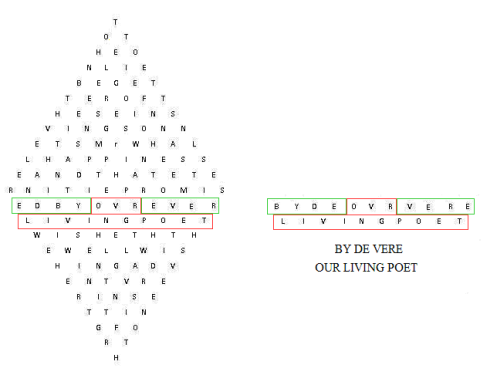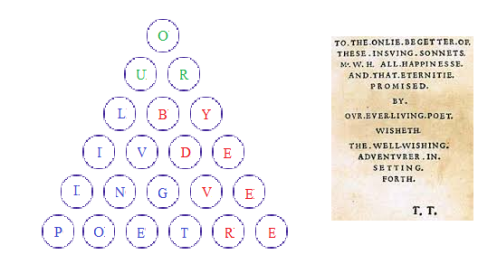Edward de Vere’s Fibonacci Diamond
The letters in the dedication of Shakespeare’s Sonnets may be arranged in diamond form and slightly rearranged to suggest that Edward de Vere is the principal author of the sonnets.

I did not try many arrangements of the dedication, only this one, as it seemed to me a natural one which nobody else had tried. I searched it for possible information on Mr W. H. not on authorship. I was content to read the line below LIVINGPOET, namely WISHETHTH as standing for WI lliam SH akespeare and TH omas TH orpe, with Shakespeare as author, particularly as Thorpe gave his initials as Th Th on a subsequent publication. I couldn’t take the Oxford theory very seriously as I believe, as I still do, that the late plays were written when most people think, however as a test for this reading I just asked how this might look to an Oxfordian as I knew that EVER was often read as E VER and VERE. When I read this I was converted, in a moment, to that the view that de VERE was, at very least, the main author of the Sonnets. (Noting the Fibonacci Relationship came a bit later). Probably many people will think I spent years trying out all sorts of arrangements of the dedication and all sorts of anagrams, I didn’t: the authorship isn’t that important to me. The two key steps, the diamond and the rearrangement of EDBY just occurred to me.
To get this arangement it is necessary that there should be a well-defined unit of text with 144 letters and that the sequence ED.BY.OUR.EVER-LIVING.POET. should be present beginning at the 79th letter. I rather suspect that if there was another instance of the phrase ‘our ever-living poet’ in Elizabethan or Jacobean literature we would know about it.
It is possible that ‘mine eye may be deceived’ and I would welcome any comments on how we might determine whether this arrangement arises by chance or design.
Update 7th November.
Since I posted this I have come to understand that Shakespeare’s favourite poet Ovid uses the name Dione, originally the mother of Venus, to stand for Venus herself. e.g. Amores 14.33. DIONE appears on a diagonal with O coinciding with O in OUR and N with N in LIVING, the line which divides the diamond into two parts of 89 and 55 letters also divides DIONE according to the Fibonacci Sequence into two parts of 3 and 2 letters. I have found more in this diamond than shown here and am also aware of other arrangements of letters giving potentially significant words and have to ask the question ‘how did anyone create this?’ I am considering the hypothesis that whoever created this started from the diamond and the two rows highlighted here.
Update Thanksgiving Day
The second hyphen divides the 16th line of 8 letters into two Fibonacci-numbered sections of 5 and 3 letters.
Thanks to a colleague, whom I’m happy to name, for pointing that THE and ONLIE are in Fibonacci/Phi relationship. In fact the first four words TO.THE.ONLIE.BEGETTER give four consecutive Fibonacci numbers 2, 3, 5, 8
The same colleague also reminded me of the arrangement of words in the dedication in three triangles of 6, 2 and 4 lines corresponding to the letters in the name Edward de Vere
